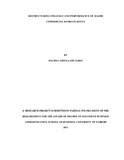| dc.description.abstract | Organizations, depending on the nature of their businesses, structure, and size employ different
strategies in order to achieve their desired level of output. The organization therefore must
implement the right strategies that they have formulated if the desired performance level is to be
achieved. (Thompson and Strickland, 2008).In an organization‘s quest to improve efficiency and
profitability, most of these organizations tend to implement a corporate restructuring strategy
involving re-building or total dismantling of areas or departments within the organization that
requires special attention from management and other stakeholders. According to Bowman et al
(1999), the consequences of restructuring can be conceptualized in terms of intermediate effects
which may have positive or negative outcomes and these intermediate effects may have some
impact on financial performance or economic wealth of the corporation. Restructuring is a
contemporary solution issue to managing and anticipating change (Acharya, 2009). The purpose of
the study is to establish the extent to which the various restructuring efforts executed at the top
performing commercial banks affect the performance of the banks. For such a study to be carried
out primary data will be used to determine the extent to which restructuring has been done by the
commercial banks. Thus questionnaires are to be administered to employees of the selected banks
to get this information and analyzed by use of men and standard deviation. The performance of the
banks is derived from secondary data that is the published financial statements. From these the
abnormal returns can be computed to determine the impact of the restructuring on the returns of
the banks. This is then followed by a t test and the findings are then presented using tables. The
study concludes that restructuring in banks leads to improved performance by the banks. The study
had several limitations such as restricted number of participants and some respondents not giving
information considered as confidential thus leading to the respondents giving unreliable
information. The study implies there is a relationship between restructuring and performance of
banks. For restructuring to be a success, management needs to take employee needs and concerns
in planning and implementation of strategies | |

